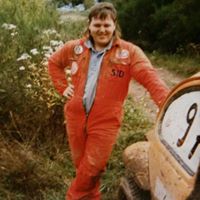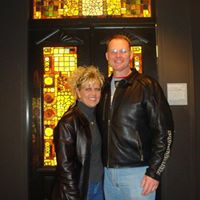Jerry Marc Lang
age ~67
from Miami, FL
- Also known as:
-
- Jerry M Lang
- Marc J Lang
- Jerry G
- Phone and address:
- 21141 NE 21St Pl, Miami, FL 33179
Jerry Lang Phones & Addresses
- 21141 NE 21St Pl, Miami, FL 33179
- N Miami Beach, FL
- Tyler, TX
- Hollister, MO
- Lindale, TX
Work
-
Company:University studios
-
Address:4715 Nw 9Th Ave, Fort Lauderdale, FL 33309
-
Phones:9547726644
-
Position:Owner
-
Industries:Photographic Studios, Portrait
Us Patents
-
Fuel Dilution Methods And Apparatus For Nox Reduction
view source -
US Patent:6383461, May 7, 2002
-
Filed:Apr 12, 2000
-
Appl. No.:09/547769
-
Inventors:Jerry M. Lang - Lindale TX
-
Assignee:John Zink Company, LLC - Tulsa OK
-
International Classification:B01D 5354
-
US Classification:423235, 110345, 422183, 423210
-
Abstract:Methods and apparatus for reducing the content of nitrogen oxides in the flue gases produced by the combustion of fuel gas and combustion air introduced into a burner connected to a furnace are provided. The methods basically comprise the steps of conducting the combustion air to the burner, providing a chamber outside of the burner and furnace for mixing flue gases from the furnace with the fuel gas, discharging the fuel gas in the form of a fuel jet into the mixing chamber so that flue gases from the furnace are drawn into the chamber and mixed with and dilute the fuel gas therein and conducting the resulting mixture of flue gases and fuel gas to the burner wherein the mixture is combined with the combustion air and burned in the furnace.
-
Fuel Dilution Methods And Apparatus For Nox Reduction
view source -
US Patent:6383462, May 7, 2002
-
Filed:Jun 20, 2000
-
Appl. No.:09/597014
-
Inventors:Jerry M. Lang - Lindale TX
-
Assignee:John Zink Company, LLC - Tulsa OK
-
International Classification:B01D 5354
-
US Classification:423235, 110345, 422183, 423210
-
Abstract:Methods and apparatus for reducing the content of nitrogen oxides in the flue gases produced by the combustion of fuel gas and combustion air introduced into a burner connected to a furnace are provided. The methods basically comprise the steps of conducting the combustion air to the burner, providing a chamber outside of the burner and furnace for mixing flue gases from the furnace with the fuel gas, discharging the fuel gas in the form of a fuel jet into the mixing chamber so that flue gases from the furnace are drawn into the chamber and mixed with and dilute the fuel gas therein and conducting the resulting mixture of flue gases and fuel gas to the burner wherein the mixture is combined with the combustion air and burned in the furnace.
-
System And Method For Separating High Molecular Weight Gases From A Combustion Source
view source -
US Patent:20120141352, Jun 7, 2012
-
Filed:Dec 7, 2011
-
Appl. No.:13/314110
-
Inventors:Jerry Lang - Lindale TX, US
David Scott - Rockwall TX, US -
International Classification:C01D 7/07
B01D 53/30
B01D 53/74
B01D 53/24 -
US Classification:423421, 95 34, 95 35, 95 14, 95 10, 95 23, 95 12, 95 1, 55414, 55415, 96408, 422168
-
Abstract:High molecular weight (HMW) gases are separated from an exhaust gas of a combustion source using a blower and an interior vent within the exhaust stack. The interior vent includes a vent wall having a top portion attached to the interior surface of the exhaust stack along the entire inner perimeter of the exhaust stack and a lower portion that extends downward into the exhaust stack to form an annular space or gap between the vent wall and the interior surface of the exhaust stack, and at least one opening in the interior surface of the exhaust stack between the top and bottom portions of the vent wall. The blower creates a tangential flow of the exhaust gas with sufficient centrifugal force to concentrate substantially all of the HMW gases along the inner surface of the exhaust stack. A transfer pipe removes the HMW gases from the interior vent.
-
Low No.sub.x Burner
view source -
US Patent:56039069, Feb 18, 1997
-
Filed:Nov 20, 1995
-
Appl. No.:8/560941
-
Inventors:Jerry M. Lang - Lindale TX
David W. Scott - Garland TX -
Assignee:Holman Boiler Works, Inc. - Dallas TX
-
International Classification:B01D 5392
-
US Classification:422182
-
Abstract:A low NO. sub. x burner combustion system which may be adjusted for optimum burn rates, temperature and oxygen levels. The burner incorporates a plurality of gas nozzles which individually inspirate a portion of the combustion air and a spin vane diffuser to rotate and mix the gases within the primary combustion zone. The diffuser is axially adjustable in order to vary the distance between the vane and the first combustion zone while the blades of the diffuser can be angularly adjusted to optimize the rotation and mix of the gases. Air for combustion is supplied through primary, secondary and tertiary passages to create distinct combustion zones for complete combustion. The flow rate of the combustion air is controlled through a damper in accordance with the burn characteristics. Further reductions in noxious emissions are accomplished by recirculating flue gases and mixing such gassed directly with combustion fuel prior to introduction into the combustion chamber through eductor nozzles. Still further reductions are attained by mixing a secondary compound such as water or a chemical into the recirculated flue gases to optimize burn levels thereby reducing emissions.
-
Low No.sub.x Burner
view source -
US Patent:52579271, Nov 2, 1993
-
Filed:Nov 1, 1991
-
Appl. No.:7/786869
-
Inventors:Jerry M. Lang - Lindale TX
-
Assignee:Holman Boiler Works, Inc. - Dallas TX
-
International Classification:E23M 900
-
US Classification:431184
-
Abstract:A low NO. sub. x burner combustion system which may be adjusted for optimum burn rates, temperature and oxygen levels. The burner incorporates a plurality of gas nozzles which individually inspirate a portion of the combustion air and a spin vane diffuser to rotate and mix the gases within the primary combustion zone. The diffuser is axially adjustable in order to vary the distance between the vane and the first combustion zone while the blades of the diffuser can be angularly adjusted to optimize the rotation and mix of the gases. Air for combustion is supplied through primary, secondary and tertiary passages to create distinct combustion zones for complete combustion. The flow rate of the combustion air is controlled through a damper in accordance with the burn characteristics. The angular and axial position of the diffuser and the damper control of combustion air can be automatically adjusted throughout the firing range of the burner in response to demand levels. In order to convert existing burners to the efficient low NO. sub.
-
Roadway Marker And Process Of And Application For Producing The Same
view source -
US Patent:41369912, Jan 30, 1979
-
Filed:Jun 2, 1977
-
Appl. No.:5/802817
-
Inventors:Elin R. Clark - Lindale TX
Benny J. Clark - Lindale TX
Jerry M. Lang - Lindale TX -
International Classification:E01F 904
-
US Classification:404 73
-
Abstract:A raised marker is produced by inserting molten resin material, which has been premixed with a hardner or catalyst, into an open mold so that the resin conforms to the shape of the mold. The mold, prior to the time the resin cures or sets up, is inverted and placed on the pavement so that the resin, itself bonds to the pavement surface. The mold may be removed or remains as a permanent shell for the marker. A parting agent is used when the mold is to be removed. Color pigments and/or inserts in the form of glass beads or other reflective elements may be incorporated in the resin. Mechanism is shown for automatically filling and depositing the molds.
-
Well Pumping Unit With Counterweight
view source -
US Patent:47198117, Jan 19, 1988
-
Filed:Feb 25, 1985
-
Appl. No.:6/704924
-
Inventors:Jerry M. Lang - Lindale TX
Gordon R. Lively - Longview TX -
Assignee:Rota-Flex Corporation - Longview TX
-
International Classification:F04B 4702
F16H 1906 -
US Classification:74 8922
-
Abstract:A well pumping unit including a derrick having first and second sheave sets attached near the top thereof, a drive mechanism, a counterweight, a polish rod assembly and cable members. The cable members form a closed loop extending from the polish rod assembly to the first sheave set, to the counterweight, to the second sheave set, to the drive mechanism, to the second sheave set, to the first sheave set and back to the polish rod assembly. The counterweight is suspended by the sheave sets and cable members between the sheave sets. When the drive mechanism operates in a first direction, the polish rod assembly is raised and the counterweight lowered. When the drive mechanism operates in a second direction, the counterweight is raised and the polish rod assembly lowered. The counterweight may be located within the derrick while the polish rod assembly and drive mechanism may be located outside of the derrick. The weight of the counterweight may be adjusted as desired.
-
Reciprocating Drive Mechanism With Positive Pinion-To-Rack Gear Engagement
view source -
US Patent:46386769, Jan 27, 1987
-
Filed:Feb 25, 1985
-
Appl. No.:6/704923
-
Inventors:Gordon R. Lively - Longview TX
Jerry M. Lang - Lindale TX -
Assignee:Rota-Flex Corporation - Longview TX
-
International Classification:F16H 2116
F16H 1908 -
US Classification:74 31
-
Abstract:A reciprocating drive mechanism powered by a rotating prime mover for use, for example, in operating oil well pumps. The drive mechanism utilizes a rotating pinion meshing with an endless arcuate rack gear to convert rotation to reciprocation and includes an assembly to provide a positive engagement between the pinion and rack gear. The prime mover is coupled to a fixed input shaft, the input shaft has the pinion coupled thereto, and an endless arcuate rack gear is rigidly coupled to an output shaft and meshes with the pinion. An arcuate cam is rigidly coupled to the arcuate rack gear and is engaged by a pair of cam followers which are also coupled to the pinion. A transmission shaft, which supports the pinion and cam followers, is parallel to and located a fixed distance from the input shaft, thereby maintaining the cam followers in positive engagement with the cam and the pinion in positive engagement with the rack gear.
Resumes

Robotic Electrical Maintence Repairman At Cequent Performance Products
view sourcePosition:
Robotic Electrical Maintenance Repairman at Cequent Performance Products
Location:
Goshen, Indiana
Industry:
Mechanical or Industrial Engineering
Work:
Cequent Performance Products - Goshen, Indiana since Jul 2010
Robotic Electrical Maintenance Repairman
Dynamic Metals, LLC - Elkhart, Indiana Area Jun 2007 - Jul 2009
Robotic Programmer
Robotic Electrical Maintenance Repairman
Dynamic Metals, LLC - Elkhart, Indiana Area Jun 2007 - Jul 2009
Robotic Programmer
Education:
Ball State University 1985 - 1987
Associates, Business
Associates, Business

Jerry Lang
view sourceLocation:
United States
Education:
St. Norbert College 1980 - 1984
bs, chemistry
bs, chemistry

Jerry Lang
view sourceLocation:
United States

President At House Of Travel
view sourcePosition:
President at House of Travel of Miami
Location:
Miami/Fort Lauderdale Area
Industry:
Leisure, Travel & Tourism
Work:
House of Travel of Miami - Aventura, FL. since Nov 1985
President
President
Education:
Boston University 1980 - 1982
BA, Economics
BA, Economics

Jerry Lang
view sourceLocation:
United States

Jerry Lang
view sourceLocation:
United States

Jerry Lang
view sourceLocation:
United States

Jerry Lang
view sourceLocation:
United States
Name / Title
Company / Classification
Phones & Addresses
Owner
University Studios
Photographic Studios, Portrait
Photographic Studios, Portrait
4715 Nw 9Th Ave, Fort Lauderdale, FL 33309
Website: universitystudios.com
Website: universitystudios.com
Owner
House Of Travel
Travel Agencies
Travel Agencies
17861 Biscayne Blvd, Miami, FL 33160
Website: houseoftravel.net
Website: houseoftravel.net
Owner
House Of Travel
Travel Agency
Travel Agency
17861 Biscayne Blvd, Aventura, FL 33160
3059313002, 3059355269, 8004431325
3059313002, 3059355269, 8004431325
Owner
University Studios
Media Production · Photographers · Photographic Studios, Portrait · Photographers-Portrait
Media Production · Photographers · Photographic Studios, Portrait · Photographers-Portrait
4715 NW 9 Ave, Fort Lauderdale, FL 33309
9547726644, 9547726696
9547726644, 9547726696
President, Director
Vanytravel, Inc
Travel Agency · Travel Agencies & Bureaus
Travel Agency · Travel Agencies & Bureaus
17861 Biscayne Blvd, Miami, FL 33160
3059313002, 3059355269
3059313002, 3059355269
Director , President
HIDE-A-WAY LAKE COMMUNITY CHURCH
1115 Lk Cross Rd, Lindale, TX 75771
1500 Lk Park Cir, Hide A Way, TX 75771
1500 Lk Park Cir, Hide A Way, TX 75771
Director, Govern
JERRY LANG ENTERPRISES, INC
PO Box 865, Lindale, TX 75771
1420 S Main St, Hide A Way, TX 75771
1420 S Main St, Hide A Way, TX 75771
WYSE CONTRACTS LLC
Lawyers & Attorneys
Vehicle Records
-
Jerry Lang
view source -
Address:PO Box 865, Lindale, TX 75771
-
VIN:1FTFW1ET3BFD38753
-
Make:FORD
-
Model:F-150
-
Year:2011
-
Jerry Lang
view source -
Address:612 Hide A Way Ln E, Hide A Way, TX 75771
-
VIN:5FNRL5H6XBB013816
-
Make:HONDA
-
Model:ODYSSEY
-
Year:2011
-
Jerry Lang
view source -
Address:612 Hide A Way Ln E, Lindale, TX 75771
-
Phone:9038825129
-
VIN:WBSNB93517CX07914
-
Make:BMW
-
Model:M5
-
Year:2007
Isbn (Books And Publications)



Classmates

Jerry Lang
view sourceSchools:
Crown Point Central High School Crown Point NY 1979-1983
Community:
Harry Gould, Deidre Lang, Gertrude Trudy, Penny Watrous

Jerry Lang
view sourceSchools:
Marana High School Tucson AZ 1999-2003
Community:
Peggy Armstrong, Darie Toole

Jerry Jackson (Lang)
view sourceSchools:
Sanders Memorial Elementary School Land O' Lakes FL 1959-1963
Community:
Teresa Bell, Hawkeye Hawks, Scott Barrow, Teresa Peel

Jerry Lang
view sourceSchools:
Climax Springs High School Climax Springs MO 1999-2003
Community:
Michelle Patton, Brandy Buckler, Brandi Phillips, Ashley Phillips, Fred Smith, Dana Swedeen, Krystal Martin, Kathleen O'kelley, Patrick Epplett

Jerry Lang
view sourceSchools:
Metzger Elementary School Tigard OR 1969-1974, Thomas R. Fowler Middle School Tigard OR 1974-1976
Community:
Kathy Sunday, Jamie Ryan, Fredrick Hagen, Cassi Reichel

Jerry Lang
view sourceSchools:
Franklin High School Franklin NE 1972-1976
Community:
Cindy Boller, Steven Wohleb, Mark Siecke, Kevin Yelken, William Gartin, Mary Steinkruger, Jud Gurney, Jimmy Andersen, Hal Shannon, Larry Wiedel

West Marshall High School...
view sourceGraduates:
Bob Lang (1976-1980),
Kendra Lafrenz (1988-1992),
Nylene Henze (1970-1974),
Jerry Lang (1974-1978)
Kendra Lafrenz (1988-1992),
Nylene Henze (1970-1974),
Jerry Lang (1974-1978)

Crown Point Central High ...
view sourceGraduates:
Jerry Lang (1979-1983),
Mark Munson (1987-1991),
Sheri Kazlo (1981-1985),
Mike Thompson (1987-1990)
Mark Munson (1987-1991),
Sheri Kazlo (1981-1985),
Mike Thompson (1987-1990)

Jerry Lang
view source
Jerry Lang
view source
Jerry Lang
view source
Jerry Lang
view source
Jerry Lang
view source
Jerry Lang
view source
Jerry Lang
view source
Jerry Lang
view sourceMyspace
Youtube
Flickr
News

'Gotham' recap, 'Rogue's Gallery'
view source- DOWN IN THE HOLE: They killed off Senator Clay Davis, err, Dr. Jerry Lang, that soon? Sheeeeeeeee-it! (Always with nine Es! Learn how to say it right here.) I was looking forward to having another Wire alum on the show. Can Bruno Heller get Kima or Bubs on the set?
- Date: Jan 06, 2015
- Category: Entertainment
- Source: Google

Yahoo CEO needs to outline his vision after layoffs
view source- have been reports that not only layoffs, but a corporate reorganization, were coming for Yahoo, which has fallen out of the top rungs of Internet companies. Last September, former CEO Carol Bartz was ousted from the company. Since then co-founder Jerry Lang and several board members have left as well.
- Date: Apr 04, 2012
- Source: Google
Googleplus

Jerry Lang
Relationship:
Married

Jerry Lang

Jerry Lang

Jerry Lang

Jerry Lang

Jerry Lang

Jerry Lang

Jerry Lang
Plaxo

Jerry Lang
view sourcejlcc

Jerry Lang
view sourceTerritory Client Executive at Avaya
Get Report for Jerry Marc Lang from Miami, FL, age ~67













